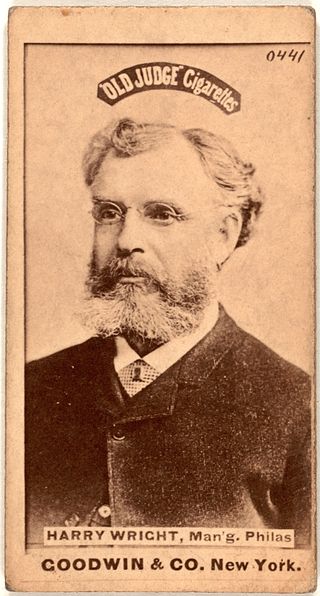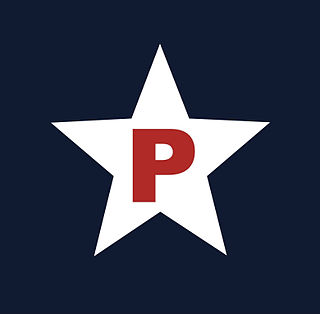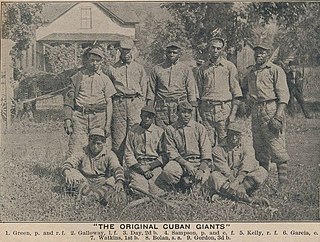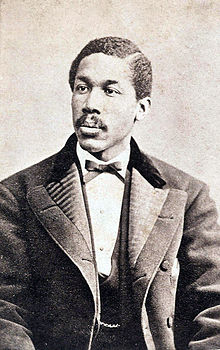The Negro leagues were United States professional baseball leagues comprising teams of African Americans. The term may be used broadly to include professional black teams outside the leagues and it may be used narrowly for the seven relatively successful leagues beginning in 1920 that are sometimes termed "Negro Major Leagues".

William Julius "Judy" Johnson was an American professional baseball third baseman, shortstop, manager and scout whose career in Negro league baseball spanned 17 seasons, from 1921 to 1937. He also played in the Cuban League. Slight of build, Johnson never developed as a power threat but achieved his greatest success as a contact hitter and an intuitive defenseman. Johnson is regarded as one of the greatest third basemen of the Negro leagues. In 1975, he was elected into the Baseball Hall of Fame after being nominated by the Negro Leagues Committee.
The color line, also known as the color barrier, in American baseball excluded players of black African descent from Major League Baseball and its affiliated Minor Leagues until 1947. Racial segregation in professional baseball was sometimes called a gentlemen's agreement, meaning a tacit understanding, as there was no written policy at the highest level of organized baseball, the major leagues. A high minor league's vote in 1887 against allowing new contracts with black players within its league sent a powerful signal that eventually led to the disappearance of blacks from the sport's other minor leagues later that century, including the low minors. After the line was in virtually full effect in the early 20th century, many black baseball clubs were established, especially during the 1920s to 1940s when there were several Negro leagues. During this period, American Indians and native Hawaiians, including Prince Oana, were able to play in the Major Leagues. The color line was broken for good when Jackie Robinson signed with the Brooklyn Dodgers organization for the 1946 season. In 1947, both Robinson in the National League and Larry Doby with the American League's Cleveland Indians appeared in games for their teams.

William Henry "Harry" Wright was an American professional baseball player, manager, and developer. He assembled, managed, and played center field for baseball's first fully professional team, the 1869 Cincinnati Red Stockings. He is credited with introducing innovations such as backing up infield plays from the outfield and shifting defensive alignments based on hitters' tendencies. For his contributions as a manager and developer of the game, he was inducted into the Baseball Hall of Fame in 1953 by the Veterans Committee.
Oakdale Park is a former baseball park that was located in Philadelphia, Pennsylvania.
The National Association of Base Ball Players (NABBP) was the first organization governing American baseball.

The Philadelphia Stars were a Negro league baseball team from Philadelphia. The Stars were founded in 1933 when Ed Bolden returned to professional black baseball after being idle since early 1930. The Stars were an independent ball club in 1933, a member of the Negro National League from 1934 until the League's collapse following the 1948 season, and affiliated with the Negro American League from 1949 to 1952.

The Cuban Giants were the first fully salaried African-American professional baseball club. The team was originally formed in 1885 at the Argyle Hotel, a summer resort in Babylon, New York. Initially an independent barnstorming team, they played games against opponents of all types: major and minor league clubs, semiprofessional teams, even college and amateur squads. They would go on to join various short-lived East Coast leagues, and in 1888 became the "World Colored Champions". Despite their name, no Cubans played on the team. The "Cubes" remained one of the premier Negro league teams for nearly 20 years, and served as a model that future black teams would emulate.

The Hilldale Athletic Club were an American professional Negro league baseball team based in Darby, Pennsylvania, west of Philadelphia.
The National Colored Base Ball League, the National Colored League, or the League of Colored Baseball Clubs was the subsequent attempt, after the Southern League of Colored Base Ballists, to have a league consisting of all-black teams. It predated Rube Foster's Negro National League by over three decades.

King Solomon "Sol" White was an American professional baseball infielder, manager and executive, and one of the pioneers of the Negro leagues. An active sportswriter for many years, he wrote the first definitive history of black baseball in 1907. He was elected to the Baseball Hall of Fame in 2006.

Octavius Valentine Catto was an American educator, intellectual, and civil rights activist. He became principal of male students at the Institute for Colored Youth, where he had also been educated. Born free in Charleston, South Carolina, in a prominent mixed-race family, he moved north as a boy with his family. After completing his education, he went into teaching, and became active in civil rights. He also became known as a top cricket and baseball player in 19th-century Philadelphia, Pennsylvania. He helped organize and played for the Philadelphia Pythians baseball team. A Republican, he was shot and killed in election-day violence in Philadelphia, where ethnic Irish of the Democratic Party, who were anti-Reconstruction and had opposed black suffrage, attacked black men to prevent their voting.
Charles Grant Jr. was an American second baseman in Negro league baseball. During his 20-year career, he played for some of the best teams in the Negro leagues. Grant nearly crossed the baseball color line in 1901 when Major League Baseball manager John McGraw attempted to pass him off as a Native American named "Tokohama".
The P.R.R. YMCA Athletic Field, also known as Penmar Park and commonly referred to in the 1930s and 1940s as the 44th and Parkside ballpark, was an athletic field and ballpark in West Philadelphia from as early as the 1890s to the early 1950s. It was built by the Pennsylvania Railroad YMCA for use by its employees. Behind the right-field fence stood the roundhouse of the main yard of the Pennsylvania Railroad. The Negro league baseball Philadelphia Stars played home games at the park from 1936 until 1952.
The New York Gorhams were a Negro league baseball team that played from 1886 to 1892. During their short existence the Gorhams grew to be one of the most successful black professional clubs in the country and challenged the supremacy of the Cuban Giants.

Jacob C. White Jr. was an American educator, intellectual, and civil rights activist. Born to a successful and influential businessman, White received the finest education afforded to African-Americans of the time and became intertwined in the dealings of Philadelphia's most prominent black leaders. The first black man in the city to be appointed as a school principal at Roberts Vaux Consolidated School. During his tenure between 1864 and 1896, White reformed the institute and became the leading figure in the field of urban education in Philadelphia. Alongside his academic endeavors, White was significant in the sports field: he helped establish the Philadelphia Pythians, an early black baseball club. Following the shooting of his friend and fellow activist Octavius Catto in 1871, White became the top civil rights activist in the city, and remained active in the community until his death in 1902.

Emilie "Emily" Frances Davis was a free African American woman living in Philadelphia during the American Civil War. She wrote three pocket diaries for the years 1863, 1864, and 1865 recounting her perspective on the Emancipation Proclamation, the Battle of Gettysburg, and the mourning of President Lincoln. These diaries are unique in their depiction of 19th century life of urban African American women and reactions to the events of the Civil War.
The Baltimore Lord Baltimores were a professional pre-Negro league baseball team based in Baltimore, Maryland in 1887. The Lord Baltimores played as charter members of the short–lived 1887 National Colored Base Ball League, hosting home games at Oriole Park.
Benjamin Banneker Institute was a literary society for African Americans established in Philadelphia in 1854. Members lectured and debated on various subjects. It was named for Benjamin Banneker.

A Quest for Parity: The Octavius V. Catto Memorial is a group of sculptures designed by Branly Cadet memorializing Octavius Catto in Philadelphia, Pennsylvania, United States. It was unveiled in 2017 and is the first monument on Philadelphia public property to commemorate a specific African American.










